Forest Canopy Height Estimation by Integrating Structural Equation Modeling and Multiple Weighted Regression
Abstract
1. Introduction
2. Materials and Methods
2.1. Study Area and Data
2.2. Polarimetric Synthetic Aperture Radar Observations
3. Research Methodology
3.1. Weight Calculation Based on Structural Equation Modeling (SEM)
3.2. Support Vector Regression Model Based on Particle Swarm Optimization (PSO-SVR)
4. Experiments and Results
4.1. Results of the Weighting Calculations
4.2. Forest Canopy Height-Weighted Estimation Results
5. Discussion
5.1. Validity of Single Polarimetric Observation Variables
5.2. Analysis of the Coupled Contribution of Multiple Polarimetric Observation Variables
5.3. Limitations and Future Research
6. Conclusions
Author Contributions
Funding
Data Availability Statement
Conflicts of Interest
References
- Zhang, Y.; Zhang, W.; Ji, Y.; Zhao, H. Forest Height Estimation and Inversion Study of Satellite-Based X-Band InSAR Data; Geomatics and Information Science of Wuhan University: Wuhan, China, 2023. [Google Scholar] [CrossRef]
- Huang, K.-X.; Xue, Z.-J.; Wu, J.-C.; Wang, H.; Zhou, H.-Q.; Xiao, Z.-B.; Zhou, W.; Cai, J.-F.; Hu, L.-W.; Ren, J.-S.; et al. Water Use Efficiency of Five Tree Species and Its Relationships with Leaf Nutrients in a Subtropical Broad-Leaf Evergreen Forest of Southern China. Forests 2023, 14, 2298. [Google Scholar] [CrossRef]
- Chen, Y.; Ma, L.; Yu, D.; Feng, K.; Wang, X.; Song, J. Improving Leaf Area Index Retrieval Using Multi-Sensor Images and Stacking Learning in Subtropical Forests of China. Remote Sens. 2022, 14, 148. [Google Scholar] [CrossRef]
- Pandit, S.; Tsuyuki, S.; Dube, T. Landscape-Scale Aboveground Biomass Estimation in Buffer Zone Community Forests of Central Nepal: Coupling In Situ Measurements with Landsat 8 Satellite Data. Remote Sens. 2018, 10, 1848. [Google Scholar] [CrossRef]
- Song, H.; Zhou, H.; Wang, H.; Ma, Y.; Zhang, Q.; Li, S. Retrieval of Tree Height Percentiles over Rugged Mountain Areas via Target Response Waveform of Satellite Lidar. Remote Sens. 2024, 16, 425. [Google Scholar] [CrossRef]
- Zörner, J.; Dymond, J.R.; Shepherd, J.D.; Wiser, S.K.; Jolly, B. LiDAR-Based Regional Inventory of Tall Trees—Wellington, New Zealand. Forests 2018, 9, 702. [Google Scholar] [CrossRef]
- Yang, H.; Chen, W.; Qian, T.; Shen, D.; Wang, J. The Extraction of Vegetation Points from LiDAR Using 3D Fractal Dimension Analyses. Remote Sens. 2015, 7, 10815–10831. [Google Scholar] [CrossRef]
- Ge, S.; Antropov, O.; Häme, T.; McRoberts, R.E.; Miettinen, J. Deep Learning Model Transfer in Forest Mapping Using Multi-Source Satellite SAR and Optical Images. Remote Sens. 2023, 15, 5152. [Google Scholar] [CrossRef]
- Husch, B.; Beers, T.W.; Kershaw, J.A. Forest Mensuration; John Wiley & Sons: Hoboken, NJ, USA, 2002. [Google Scholar]
- Huang, W.; Sun, G.; Dubayah, R.; Cook, B.; Montesano, P.; Ni, W.; Zhang, Z. Mapping biomass change after forest disturbance: Applying LiDAR footprint-derived models at key map scales. Remote Sens. Environ. 2013, 134, 319–332. [Google Scholar] [CrossRef]
- Voudouri, K.A.; Michailidis, K.; Koukouli, M.-E.; Rémy, S.; Inness, A.; Taha, G.; Peletidou, G.; Siomos, N.; Balis, D.; Parrington, M. Investigating a Persistent Stratospheric Aerosol Layer Observed over Southern Europe during 2019. Remote Sens. 2023, 15, 5394. [Google Scholar] [CrossRef]
- Wang, C.; Morgan, G.R.; Morris, J.T. Drone Lidar Deep Learning for Fine-Scale Bare Earth Surface and 3D Marsh Mapping in Intertidal Estuaries. Sustainability 2023, 15, 15823. [Google Scholar] [CrossRef]
- Li, Z.Y.; Liu, Q.W.; Pang, Y. Review on forest parameters estimation using LiDAR. J. Remote Sens. 2016, 20, 1138–1150. [Google Scholar] [CrossRef]
- Dong, J.C.; Ni, W.J.; Zhang, Z.Y.; Sun, G.Q. Performance of ICESat-2 ATL08 product on the estimation of forest height by referencing to small footprint LiDAR data. Natl. Remote Sens. Bull. 2021, 25, 1294–1307. [Google Scholar] [CrossRef]
- Lamping, J.E.; Zald, H.S.J.; Madurapperuma, B.D.; Graham, J. Comparison of Low-Cost Commercial Unpiloted Digital Aerial Photogrammetry to Airborne Laser Scanning across Multiple Forest Types in California, USA. Remote Sens. 2021, 13, 4292. [Google Scholar] [CrossRef]
- Erten, E.; Lopez-Sanchez, J.M.; Yuzugullu, O.; Hajnsek, I. Retrieval of agricultural crop height from space: A comparison of SAR techniques. Remote Sens. Environ. 2016, 187, 130–144. [Google Scholar] [CrossRef]
- Zhang, Y.; Zhao, H.; Ji, Y.; Zhang, T.; Zhang, W. Forest Height Inversion via RVoG Model and Its Uncertainties Analysis via Bayesian Framework—Comparisons of Different Wavelengths and Baselines. Forests 2023, 14, 1408. [Google Scholar] [CrossRef]
- Sharifi, A.; Amini, J. Forest biomass estimation using synthetic aperture radar polarimetric features. J. Appl. Remote Sens. 2015, 9, 097695. [Google Scholar] [CrossRef]
- Zhang, B.; Zhu, H.; Xu, W.; Xu, S.; Chang, X.; Song, W.; Zhu, J. A Fourier–Legendre Polynomial Forest Height Inversion Model Based on a Single-Baseline Configuration. Forests 2024, 15, 49. [Google Scholar] [CrossRef]
- Zhang, B.; Fu, H.; Zhu, J.; Peng, X.; Lin, D.; Xie, Q.; Hu, J. Forest height estimation using multibaseline low-frequency PolInSAR data affected by temporal decorrelation. IEEE Geosci. Remote Sens. Lett. 2021, 19, 3052727. [Google Scholar] [CrossRef]
- Li, D.; Wang, C.; Hu, Y.; Liu, S. General Review on Remote Sensing-Based Biomass Estimation. Geomat. Inf. Sci. Wuhan Univ. 2012, 37, 631635. [Google Scholar] [CrossRef]
- Zhao, M.Y.; Liu, H.Y.; Zhang, X.L.; Jiao, Z.M.; Yao, Z.; Yang, M. Estimation of forest structural parameters based on stand structure response and PALSAR data. J. Beijing For. Univ. 2015, 37, 61–69. [Google Scholar]
- Ni, W.J.; Guo, Z.F.; Sun, G.Q. Improvement of a 3D radar backscattering model using matrix-doubling method. Sci. China Earth Sci. 2010, 53, 1029–1035. [Google Scholar] [CrossRef]
- Liu, D.; Du, Y.; Sun, G.; Yan, W.-Z.; Wu, B.-I. Analysis of InSAR Sensitivity to Forest Structure based on Radar Scattering Model. Prog. Electromagn. Res. 2008, 84, 149–171. [Google Scholar] [CrossRef]
- Sun, G.; Ranson, K.J. A three-dimensional radar backscatter model of forest canopies. IEEE Trans. Geosci. Remote Sens. 1995, 33, 372–382. [Google Scholar] [CrossRef]
- Chen, K.S. Microwave Scattering and Emission Models and Their Applications; Artech House: New York, NY, USA, 1994. [Google Scholar]
- Du, J.; Shi, J.; Tjuatja, S.; Chen, K.S. A combined method to model microwave scattering from a forest medium. IEEE Trans. Geosci. Remote Sens. 2006, 44, 815–824. [Google Scholar]
- Zhang, N.; Chen, M.; Yang, F.; Yang, C.; Yang, P.; Gao, Y.; Shang, Y.; Peng, D. Forest Height Mapping Using Feature Selection and Machine Learning by Integrating Multi-Source Satellite Data in Baoding City, North China. Remote Sens. 2022, 14, 4434. [Google Scholar] [CrossRef]
- Pourshamsi, M.; Xia, J.; Yokoya, N.; Garcia, M.; Lavalle, M.; Pottier, E.; Balzter, H. Tropical forest canopy height estimation from combined polarimetric SAR and LiDAR using machine-learning. ISPRS J. Photogramm. Remote Sens. 2021, 172, 79–94. [Google Scholar] [CrossRef]
- Zhang, Y.; Peng, X.; Xie, Q.; Du, Y.; Zhang, B.; Luo, X.; Zhao, S.; Hu, Z.; Li, X. Forest height estimation combining single-polarization tomographic and PolSAR data. Int. J. Appl. Earth Obs. Geoinf. 2023, 124, 103532. [Google Scholar] [CrossRef]
- Kurvonen, L.; Pulliainen, J.; Hallikainen, M.; Mikkela, P. Retrieval of forest parameters from multitemporal spaceborne SAR data. In IGARSS’96. International Geoscience and Remote Sensing Symposium; IEEE: Piscataway, NJ, USA, 1996; Volume 3, pp. 1759–1762. [Google Scholar]
- Babu, A.; Kumar, S. Tree canopy height estimation using multi baseline RVoG inversion technique. Int. Arch. Photogramm. Remote Sens. Spat. Inf. Sci. ISPRS Arch. 2018, 42, 605–611. [Google Scholar] [CrossRef]
- Kumar, S.; Govil, H.; Srivastava, P.K.; Thakur, P.K.; Kushwaha, S.P. Spaceborne Multifrequency PolInSAR-Based Inversion Modelling for Forest Height Retrieval. Remote Sens. 2020, 12, 4042. [Google Scholar] [CrossRef]
- Chand, T.R.K.; Badarinath, K.V.S. Analysis of ENVISAT ASAR data for forest parameter retrieval and forest type classification-A case study over deciduous forests of central India. Int. J. Remote Sens. 2007, 28, 4985–4999. [Google Scholar] [CrossRef]
- Mette, T.; Papathanassiou, K.; Hajnsek, I.; Pretzsch, H.; Biber, P. Applying a common allometric equation to convert forest height from Pol-InSAR data to forest biomass. In IGARSS 2004. 2004 IEEE International Geoscience and Remote Sensing Symposium; IEEE: Piscataway, NJ, USA, 2004; Volume 1. [Google Scholar]
- Shi, Y.; Shi, S.; Huang, X. the application of structural equation modeling in ecology based on R. Chin. J. Ecol. 2022, 41, 1015–1023. [Google Scholar] [CrossRef]
- Grace, J.B. Structural Equation Modeling and Natural Systems; Cambridge University Press: Cambridge, UK, 2006. [Google Scholar]
- Wang, D.; Wan, B.; Qiu, P.; Zuo, Z.; Wang, R.; Wu, X. Mapping Height and Aboveground Biomass of Mangrove Forests on Hainan Island Using UAV-LiDAR Sampling. Remote Sens. 2019, 11, 2156. [Google Scholar] [CrossRef]
- Liu, X.; Su, Y.; Hu, T.; Yang, Q.; Liu, B.; Deng, Y.; Tang, H.; Tang, Z.; Fang, J.; Guo, Q. Neural network guided interpolation for mapping canopy height of China’s forests by integrating GEDI and ICESat-2 data. Remote Sens. Environ. 2022, 269, 112844. [Google Scholar] [CrossRef]
- Minowa, Y.; Kubota, Y.; Nakatsukasa, S. Verification of a Deep Learning-Based Tree Species Identification Model Using Images of Broadleaf and Coniferous Tree Leaves. Forests 2022, 13, 943. [Google Scholar] [CrossRef]
- Liu, A.; Cheng, X.; Chen, Z. Performance evaluation of GEDI and ICESat-2 laser altimeter data for terrain and canopy height retrievals. Remote Sens. Environ. 2021, 264, 112571. [Google Scholar] [CrossRef]
- Luo, H.; Yue, C.; Yuan, H.; Chen, S. Improving Forest Canopy Height Estimation Using a Semi-Empirical Approach to Overcome TomoSAR Phase Errors. Forests 2023, 14, 1479. [Google Scholar] [CrossRef]
- Ghosh, S.M.; Behera, M.D.; Kumar, S.; Das, P.; Prakash, A.J.; Bhaskaran, P.K.; Roy, P.S.; Barik, S.K.; Jeganathan, C.; Srivastava, P.K.; et al. Predicting the Forest Canopy Height from LiDAR and Multi-Sensor Data Using Machine Learning over India. Remote Sens. 2022, 14, 5968. [Google Scholar] [CrossRef]
- Qin, W.; Song, Y.; Zou, Y.; Zhu, H.; Guan, H. A Novel ICESat-2 Signal Photon Extraction Method Based on Convolutional Neural Network. Remote Sens. 2024, 16, 203. [Google Scholar] [CrossRef]
- Chen, L.; Xing, S.; Zhang, G.; Guo, S.; Gao, M. Refraction Correction Based on ATL03 Photon Parameter Tracking for Improving ICESat-2 Bathymetry Accuracy. Remote Sens. 2024, 16, 84. [Google Scholar] [CrossRef]
- Neuenschwander, A.; Pitts, K. The ATL08 land and vegetation product for the ICESat-2 Mission. Remote Sens. Environ. 2019, 221, 247–259. [Google Scholar] [CrossRef]
- Huang, X.; Cheng, F.; Wang, J.; Duan, P.; Wang, J. Forest Canopy Height Extraction Method Based on ICESat-2/ATLAS Data. IEEE Trans. Geosci. Remote Sens. 2023, 61, 5700814. [Google Scholar] [CrossRef]
- Li, B.; Zhao, T.; Su, X.; Fan, G.; Zhang, W.; Deng, Z.; Yu, Y. Correction of Terrain Effects on Forest Canopy Height Estimation Using ICESat-2 and High Spatial Resolution Images. Remote Sens. 2022, 14, 4453. [Google Scholar] [CrossRef]
- Cloude, S. Polarization: Applications in Remote Sensing; OUP Oxford: Oxford, UK, 2009. [Google Scholar]
- Lee, J.-S.; Eric, P. Polarimetric Radar Imaging: From Basics to Applications; CRC Press: Boca Raton, FL, USA, 2017. [Google Scholar]
- Aghabalaei, A.; Ebadi, H.; Maghsoudi, Y. Forest height estimation based on the RVoG inversion model and the PolInSAR decomposition technique. Int. J. Remote Sens. 2020, 41, 2684–2703. [Google Scholar] [CrossRef]
- Wang, X.; Feng, X. Determination of the Optimum kz for L-band PolInSAR Forest Height Estimation. IEEE Geosci. Remote Sens. Lett. 2023. [Google Scholar] [CrossRef]
- Huang, Z.; Lv, X.; Li, X.; Chai, H. Maximum a Posteriori Inversion for Forest Height Estimation Using Spaceborne Polarimetric SAR Interferometry. IEEE Trans. Geosci. Remote Sens. 2023. [Google Scholar] [CrossRef]
- Xie, Q.; Wang, J.; Lopez-Sanchez, J.M.; Peng, X.; Liao, C.; Shang, J.; Zhu, J.; Fu, H.; Ballester-Berman, J.D. Crop Height Estimation of Corn from Multi-Year RADARSAT-2 Polarimetric Observables Using Machine Learning. Remote Sens. 2021, 13, 392. [Google Scholar] [CrossRef]
- Freeman, A.; Durden, S.L. A three-component scattering model for polarimetric SAR data. IEEE Trans. Geosci. Remote Sens. 1998, 36, 963–973. [Google Scholar] [CrossRef]
- Kim, Y.; van Zyl, J. Comparison of forest parameter estimation techniques using SAR data. In IGARSS 2001, Scanning the Present and Resolving the Future, Proceedings of the IEEE 2001 International Geoscience and Remote Sensing Symposium (Cat. No. 01CH37217), Sydney, NSW, Australia, 9–13 July 2001; IEEE: New York, NY, USA, 2001; Volume 3, pp. 1395–1397. [Google Scholar]
- Mardani, A.; Streimikiene, D.; Zavadskas, E.K.; Cavallaro, F.; Nilashi, M.; Jusoh, A.; Zare, H. Application of Structural Equation Modeling (SEM) to solve environmental sustainability problems: A comprehensive review and meta-analysis. Sustainability 2017, 9, 1814. [Google Scholar] [CrossRef]
- Zhu, H.; Zhang, B.; Song, W.; Dai, J.; Lan, X.; Chang, X. Power-Weighted Prediction of Photovoltaic Power Generation in the Con-text of Structural Equation Modeling. Sustainability 2023, 15, 10808. [Google Scholar] [CrossRef]
- Chang, X.; Zhang, B.; Zhu, H.; Song, W.; Ren, D.; Dai, J. A Spatial and Temporal Evolution Analysis of Desert Land Changes in Inner Mongolia by Combining a Structural Equation Model and Deep Learning. Remote Sens. 2023, 15, 3617. [Google Scholar] [CrossRef]
- Damgaard, C. Spatio-Temporal Structural Equation Modeling in a Hierarchical Bayesian Framework: What Controls Wet Heathland Vegetation? Ecosystems 2019, 22, 152–164. [Google Scholar] [CrossRef]
- Zhu, T.; Guo, Y.; Wang, C.; Ni, C. Inter-hour forecast of solar radiation based on the structural equation model and ensemble model. Energies 2020, 13, 4534. [Google Scholar] [CrossRef]
- De Maesschalck, R.; Jouan-Rimbaud, D.; Massart, D.L. The Mahalanobis distance. Chemom. Intell. Lab. Syst. 2000, 50, 1–18. [Google Scholar] [CrossRef]
- Shi, Y.; Xu, L.; Zhou, Y.; Ji, B.; Zhou, G.; Fang, H.; Yin, J.; Deng, X. Quantifying driving factors of vegetation carbon stocks of Moso bamboo forests using machine learning algorithm combined with structural equation model. For. Ecol. Manag. 2018, 429, 406–413. [Google Scholar] [CrossRef]
- Sun, X.; Wang, B.; Xiang, M.; Zhou, L.; Jiang, S. Forest height estimation based on P-band pol-inSAR modeling and multi-baseline inversion. Remote Sens. 2020, 12, 1319. [Google Scholar] [CrossRef]
- Mahalanobis, P.C. Mahalanobis distance. Proc. Natl. Inst. Sci. India 1936, 49, 234–256. [Google Scholar]
- Zhu, X.X.; Tuia, D.; Mou, L.; Xia, G.-S.; Zhang, L.; Xu, F.; Fraundorfer, F. Deep learning in remote sensing: A comprehensive review and list of resources. IEEE Geosci. Remote Sens. Mag. 2017, 5, 8–36. [Google Scholar] [CrossRef]
- Zhang, L.; Zhang, L.; Du, B. Deep learning for remote sensing data: A technical tutorial on the state of the art. IEEE Geosci. Remote Sens. Mag. 2016, 4, 22–40. [Google Scholar] [CrossRef]
- Tian, Y.; Huang, H.; Zhou, G.; Zhang, Q.; Tao, J.; Zhang, Y.; Lin, J. Aboveground mangrove biomass estimation in Beibu Gulf using machine learning and UAV remote sensing. Sci. Total Environ. 2021, 781, 146816. [Google Scholar] [CrossRef]
- Huang, Z.; Tian, Y.; Zhang, Q.; Huang, Y.; Liu, R.; Huang, H.; Zhou, G.; Wang, J.; Tao, J.; Yang, Y.; et al. Estimating mangrove above-ground biomass at Maowei Sea, Beibu Gulf of China using machine learning algorithm with Sentinel-1 and Sentinel-2 data. Geocarto Int. 2022, 37, 15778–15805. [Google Scholar] [CrossRef]
- Zhang, S.; Tian, J.; Lu, X.; Tian, Q. Temporal and spatial dynamics distribution of organic carbon content of surface soil in coastal wetlands of Yancheng, China from 2000 to 2022 based on Landsat images. China from 2000 to 2022 based on Landsat images. Catena 2023, 223, 106961. [Google Scholar] [CrossRef]
- Kennedy, J.; Russell, E. Particle swarm optimization. In Proceedings of the ICNN’95 International Conference on Neural Networks, Perth, WA, Australia, 27 November–1 December 1995; IEEE: Piscataway, NJ, USA, 1995; Volume 4. [Google Scholar]
- Hosseini, M.; Naeini, S.A.M.; Dehghani, A.A.; Khaledian, Y. Estimation of soil mechanical resistance parameter by using particle swarm optimization, genetic algorithm and multiple regression methods. Soil Tillage Res. 2016, 157, 32–42. [Google Scholar] [CrossRef]
- Fu, C.; Gan, S.; Yuan, X.; Xiong, H.; Tian, A. Determination of soil salt content using a probability neural network model based on particle swarm optimization in areas affected and non-affected by human activities. Remote Sens. 2018, 10, 1387. [Google Scholar] [CrossRef]
- Awad, M.; Khanna, R.; Awad, M.; Khanna, R. Support vector regression. In Efficient Learning Machines: Theories, Concepts, and Applications for Engineers and System Designers; Apress: Berkeley, CA, USA, 2015; pp. 67–80. [Google Scholar]
- Benesty, J.; Chen, J.; Huang, Y.; Cohen, I. Pearson Correlation Coefficient. In Noise Reduction in Speech Processing; Springer Topics in Signal Processing; Springer: Berlin/Heidelberg, Germany, 2009; Volume 2. [Google Scholar] [CrossRef]
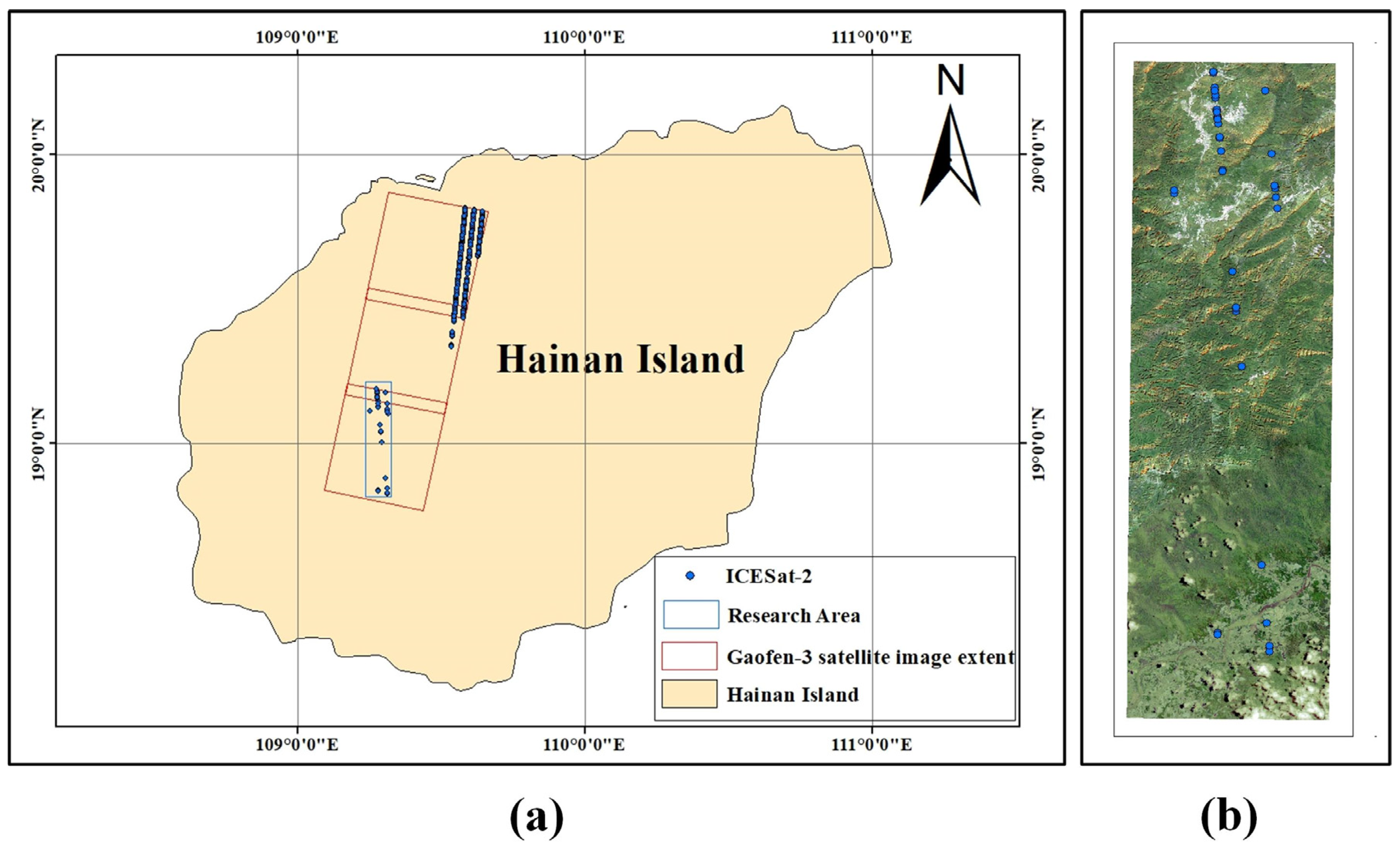
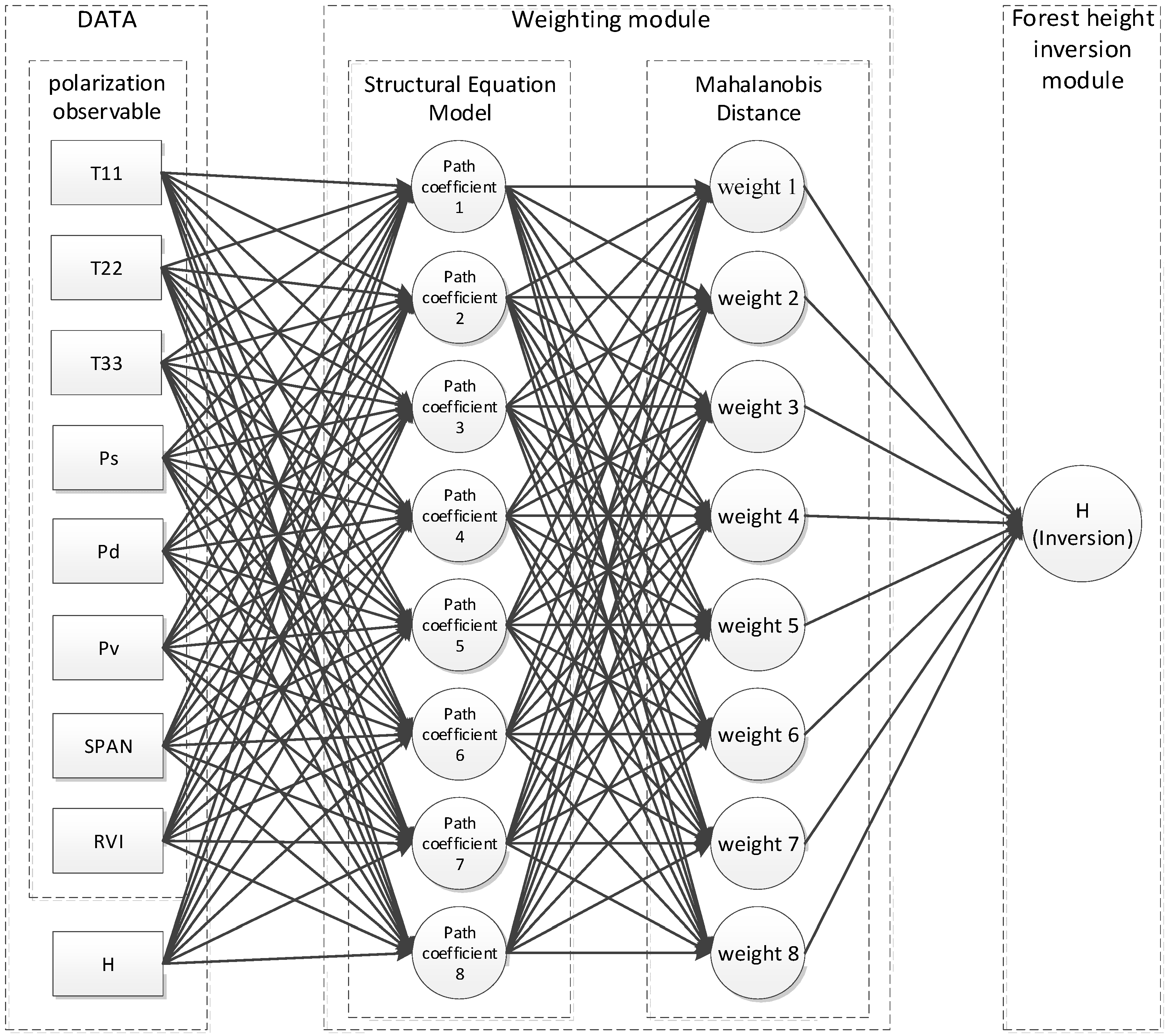

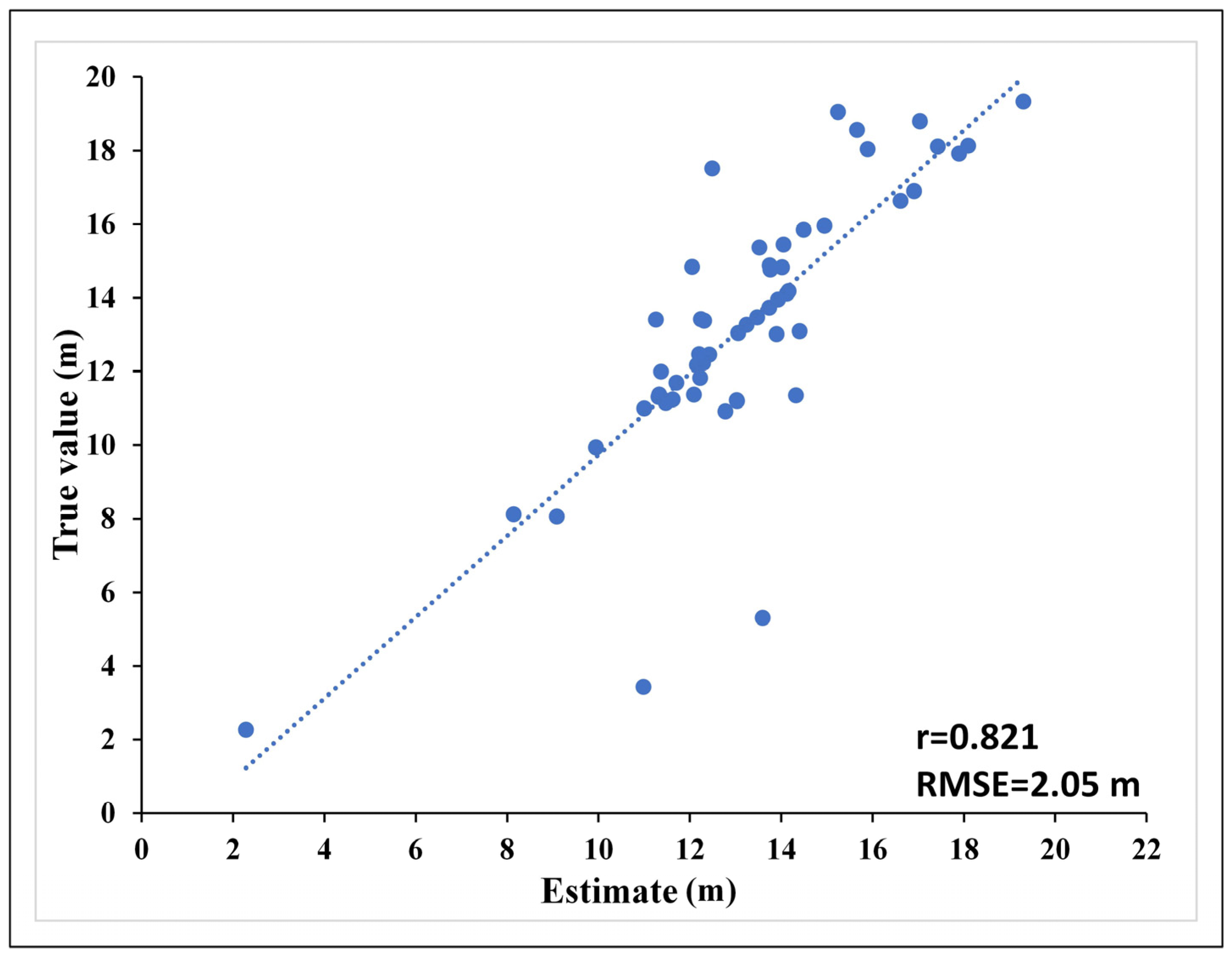

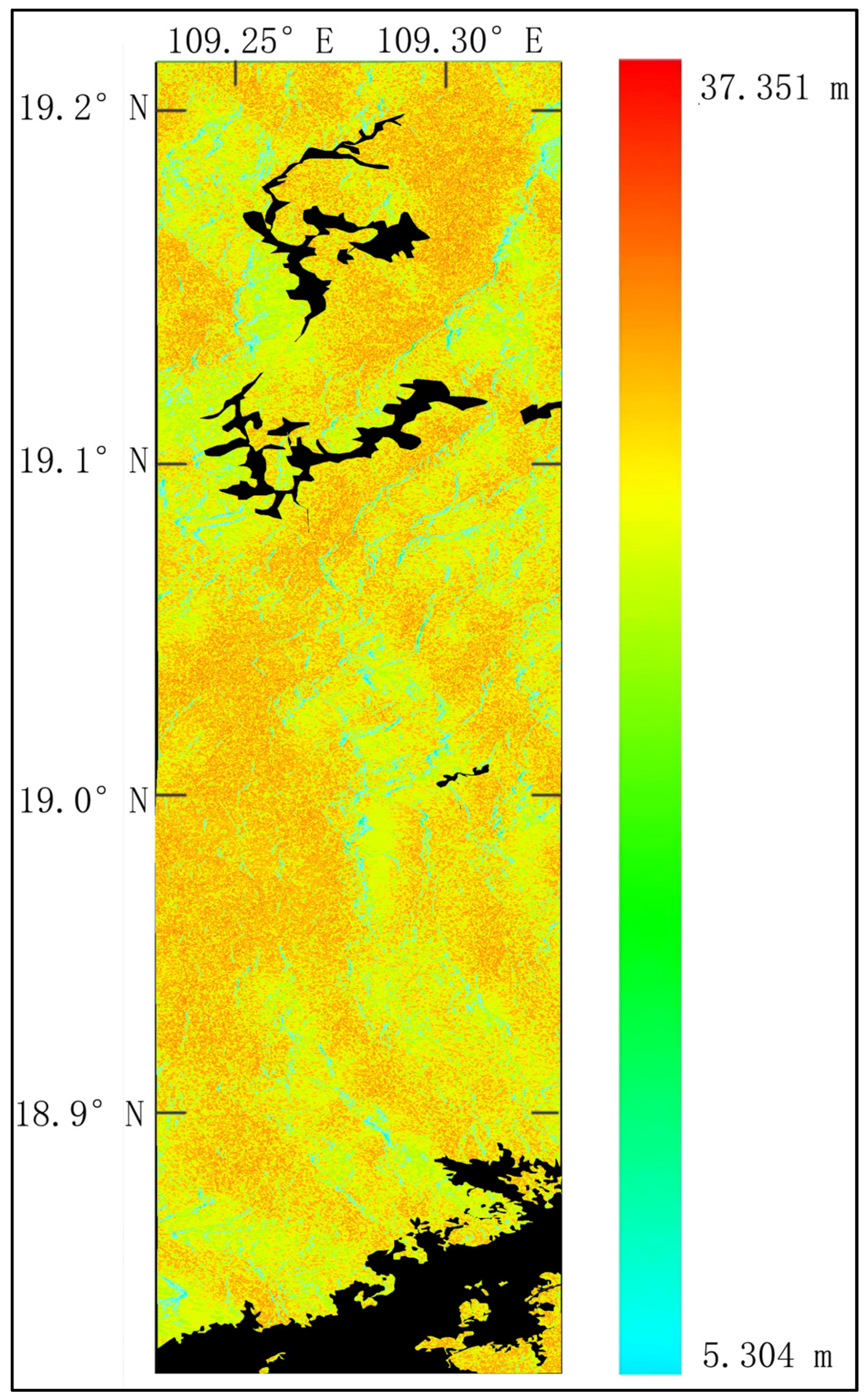
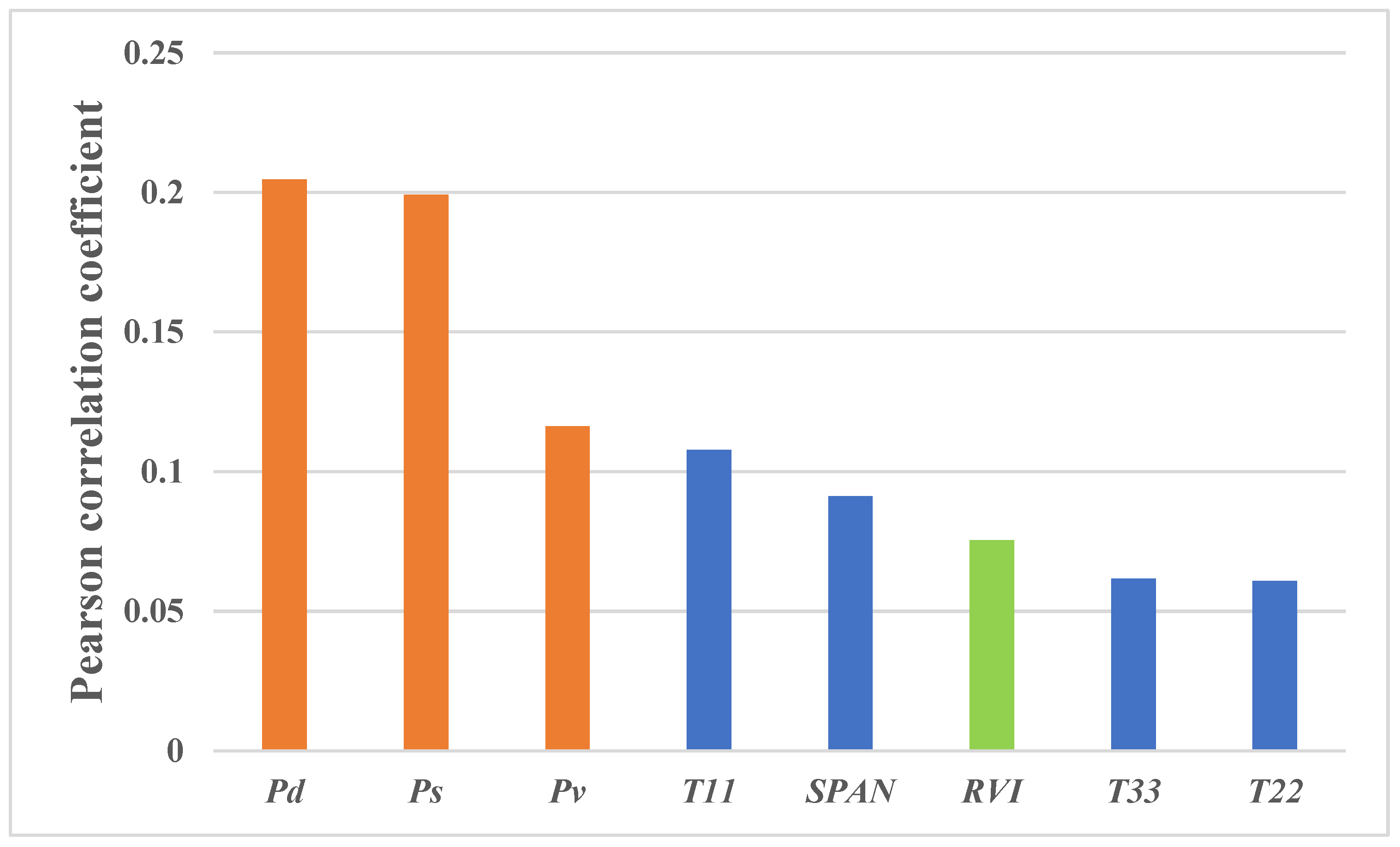
| Date | Mode | Center Longitude | Center Latitude | Resolution |
|---|---|---|---|---|
| 05 January 2021 | QPS1 | 109.3° E | 19.0° N | 8.0 m × 8.0 m |
| 05 January 2021 | QPS1 | 109.4° E | 19.3° N | 8.0 m × 8.0 m |
| 05 January 2021 | QPS1 | 109.5° E | 19.6° N | 8.0 m × 8.0 m |
| Polarimetric Observation Variable | Description |
|---|---|
| T11, T22, T33 | Backscattering coefficients in the Pauli polarization channels |
| SPAN | Total backscattered power |
| Ps, Pd, Pv | Scattering power from the different scattering mechanisms derived from Freeman-Durden decomposition |
| RVI | Radar vegetation index |
| Polarimetric Observation Variable | Path Coefficient | Weight |
|---|---|---|
| T11 | 0.163 | 1.144 |
| T22 | 0.101 | 0.581 |
| T33 | 0.11 | 3.766 |
| SPAN | 0.109 | 2.067 |
| RVI | 0.058 | 2.774 |
| Ps | 0.08 | 1.306 |
| Pd | −0.069 | 2.111 |
| Pv | 0.093 | 1 |
Disclaimer/Publisher’s Note: The statements, opinions and data contained in all publications are solely those of the individual author(s) and contributor(s) and not of MDPI and/or the editor(s). MDPI and/or the editor(s) disclaim responsibility for any injury to people or property resulting from any ideas, methods, instructions or products referred to in the content. |
© 2024 by the authors. Licensee MDPI, Basel, Switzerland. This article is an open access article distributed under the terms and conditions of the Creative Commons Attribution (CC BY) license (https://creativecommons.org/licenses/by/4.0/).
Share and Cite
Zhu, H.; Zhang, B.; Song, W.; Xie, Q.; Chang, X.; Zhao, R. Forest Canopy Height Estimation by Integrating Structural Equation Modeling and Multiple Weighted Regression. Forests 2024, 15, 369. https://doi.org/10.3390/f15020369
Zhu H, Zhang B, Song W, Xie Q, Chang X, Zhao R. Forest Canopy Height Estimation by Integrating Structural Equation Modeling and Multiple Weighted Regression. Forests. 2024; 15(2):369. https://doi.org/10.3390/f15020369
Chicago/Turabian StyleZhu, Hongbo, Bing Zhang, Weidong Song, Qinghua Xie, Xinyue Chang, and Ruishan Zhao. 2024. "Forest Canopy Height Estimation by Integrating Structural Equation Modeling and Multiple Weighted Regression" Forests 15, no. 2: 369. https://doi.org/10.3390/f15020369
APA StyleZhu, H., Zhang, B., Song, W., Xie, Q., Chang, X., & Zhao, R. (2024). Forest Canopy Height Estimation by Integrating Structural Equation Modeling and Multiple Weighted Regression. Forests, 15(2), 369. https://doi.org/10.3390/f15020369






